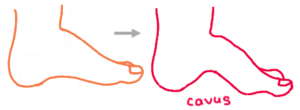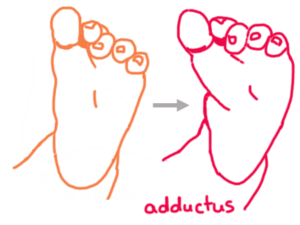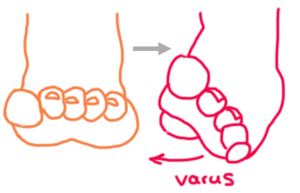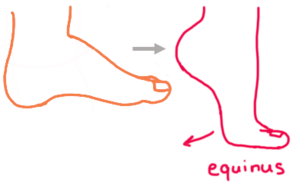Club foot facts for kids
A club foot or clubfoot, also called congenital talipes equinovarus (CTEV), is a birth defect where one or both feet are rotated inward and downward. The affected foot and leg may be smaller than the other. In approximately 50% of cases, clubfoot affects both feet.
Without appropriate treatment, the foot deformity will persist and lead to pain and impaired ability to walk, which can have a dramatic impact on the quality of life.
The exact cause is usually not identified. Both genetic and environmental factors are believed to be involved.
Clubfoot occurs in 1 to 4 of every 1,000 live births, making it one of the most common birth defects affecting the legs. About 80% of cases occur in developing countries where there is limited access to care. Clubfoot is more common in firstborn children and males. It is more common among Māori people, and less common among Chinese people.
Contents
History
Pharaohs Siptah and Tutankhamun had clubfeet, and the condition appears in Egyptian paintings. Indian texts (c. 1000 BC) and Hippocrates (c. 400 BC) describe treatment. In 1823, Delpech presented a new procedure to treat the condition. The new method, known as tenotomy, involved the cutting of the Achilles tendon. The surgical procedure had complications such as infections.
Diagnosis
Clubfoot is diagnosed through physical examination. Typically, babies are examined from head-to-toe shortly after they are born. There are four components of the clubfoot deformity:
Sometimes, it is possible to detect clubfoot before birth using ultrasound.
Treatment
The most common initial treatment is the Ponseti method, which is divided into two phases: 1) correcting of foot position and 2) casting at repeated weekly intervals. If the clubfoot deformity does not improve by the end of the casting phase, an Achilles tendon tenotomy can be performed. The procedure consists of a small posterior skin incision through which the tendon cut is made. In order to maintain the correct position of the foot, it is necessary to wear an orthopedic brace until 5 years of age.
Initially, the brace is worn nearly continuously and then just at night. In about 20% of cases, further surgery is required. Treatment can be carried out by a range of healthcare providers and can generally be achieved in the developing world with few resources.
Images for kids
See also
 In Spanish: Pie equinovaro para niños
In Spanish: Pie equinovaro para niños







